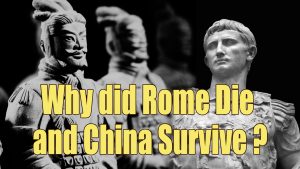China Adopted Capitalism 2000 Years Earlier than the West?

China is a unique phenomenon in human history. While it has not made as much contributions to science and technology as Mediterranean and Indian civilization, what truly sets Chinese civilization apart is its political, economic, and social organizational systems.
1 The Great Unity
Before the Industrial Revolution, a vast, populous country shouldn’t exist. First, central authority couldn’t effectively control local regions. Second, geographical barriers hindered communication between ethnic groups, leading to natural divisions.
The so-called vast empires spanning Europe, Asia, and Africa mentioned in history textbooks actually ruled indirectly, resulting in limited territorial control that usually leads to rapid collapse. In contrast, ancient China’s ability to maintain effective control, even at the county level, over remote areas, is remarkable. From a global historical perspective, there are many reasons for Chinese civilization should have collapsed or fragmented.
Many argue that China’s geographic isolation prevented external exploration and led to internal competition, making fragmentation impossible. This view neglects scientific reasoning—before industrialization, weren’t all civilizations isolated? Europe’s geography is similar to China’s, divided by seas, deserts, and mountains. Middle Eastern and Eastern European peoples invaded West Europe is just like northern nomadic groups invaded China’s core area. Indian civilization occupies the South Asian subcontinent, remaining largely isolated except in the northwest. Japan is essentially a fragmented island. The only region that isn’t isolated is the Middle East, with foreign ethnic groups taking turns to rule.
 The Great Wall, which was the ancient border between China and northern nomadic nations, is now in the interior of China.
The Great Wall, which was the ancient border between China and northern nomadic nations, is now in the interior of China.
Some also claim that the unifying force of the Chinese language created a strong cultural bond.
Then why did Qin Shi Huang unify the character shapes? It was precisely because the character shapes of the various states had diverged significantly. Although they all evolved from the Zhou Dynasty’s big seal script, the differences became quite clear after the long Eastern Zhou periods.
 Comparison of Character Shapes Among Major States During the Warring States Period
Comparison of Character Shapes Among Major States During the Warring States Period
Throughout Chinese history, there have been at least three major periods of fragmentation similar to the Eastern Zhou period. These include the 500 years of the Eastern Zhou, the 400 years from the end of the Eastern Han to the Tang Dynasty, and the 400 years from the end of the Tang to the Yuan Dynasty. Each major period of fragmentation lasted four to five centuries. For context, the United States has only existed for a little over 200 years.
Just by reviewing the notes of envoys from the Song and Liao dynasties, you can see how quickly language differentiates. In just a few decades, Han people could be assimilated by minority groups and would primarily speak the languages of those groups.
The Mandarin spoken by Chinese people today has developed from a common northern dialect with a history of only six hundred years. While it can be traced back to the universal dialect of the Zhou Dynasty three thousand years ago, relying solely on language and writing to maintain unity is clearly insufficient.
Such significant periods of fragmentation lasting for hundreds of years have occurred multiple times in Chinese history. For any other civilization on Earth, this would likely mean that reunification is impossible. The Latin-speaking peoples were divided into several nations, the Germanic peoples also split into multiple states, and the Slavic peoples further fragmented into various countries.
However, China does not fit either of these scenarios. First, since the fall of the Shang dynasty and the establishment of the Zhou dynasty, central royal authority no longer monopolized religious power. Second, the central authority of various dynasties lacked a common bloodline, especially when considering the Mongol-led Yuan dynasty and the Manchu-led Qing dynasty.
So, compared to other civilizations around the world, Chinese civilization should have fragmented rather than persisted, with no reason to maintain unity. Yet, it has not divided; instead, it has traversed the long history of humanity while largely maintaining the state of great unity up to the now. Why? Simply put, it comes down to money—or more precisely, a forward-thinking economic model.
2 Agricultural Capitalism in 300 BCE
The Shang Yang Reforms was a pivotal event in Chinese history, determining the fate of Chinese civilization. It can be said that China before and after these reforms was totally different. One of the key aspects of the Shang Yang Reforms was the allowance for land transactions. By abolishing the communal land system known as the “well-field system” and permitting land sales, China suddenly entered a capitalist society.
 Portrait of Shang Yang
Portrait of Shang Yang
Yes, by 300 BCE, China had entered the capitalist phase.
From a historical materialist perspective, studying ancient societies requires first examining their economic systems, as the economic base determines the superstructure. Ancient economies were primarily agrarian, and the core issue in agriculture was land ownership. However, for nearly a century, historical research has strangely overlooked this crucial topic.
From the Shang Yang Reforms to the British bourgeois revolution, nearly two thousand years of human history, China is the only civilization that consistently allowed the buying and selling of land.
While there may have been restrictions at the beginning of each dynasty, there were often significant underground transactions. The central authorities attempted to ban these practices but ultimately had to tolerate them. Therefore, over a longer time scale, land transactions were generally permitted.
How unique was this system? It was so distinctive that even the closest vassal state of China, the ancient Joseon Kingdom of Korea, did not adopt it. For most of its history, Korea maintained a system of hereditary land ownership. Japan, on the other hand, followed a more typical feudal system. While Rome did allow land transactions at one point, it was not comprehensive. After the fall of Rome, European civilization did not permit the buying and selling of land for a long time.
Europe truly established a comprehensive system of private land ownership and allowed land transactions only after the English bourgeois revolution in the 17th century. Even Tsarist Russia did not permit the free sale of land until the Stolypin reforms in 1906.
India only broke rural land communalism in the 18th century with the introduction of the zamindari system by the British colonizers.
The Ottoman Empire’s tax farming system functioned as a hereditary landholding system that also prohibited land sales.
The land system is the cornerstone of ancient economic societies. China’s land system differs fundamentally from those of other civilizations, making it unlikely for a similar civilization to develop elsewhere.
Marx, in his “Critique of Hegel’s Philosophy of Right,” argued that the non-transferability of land is a core attribute of feudal economies and a key standard distinguishing feudal and non-feudal systems.
Once land can be bought and sold, it means that wealth is no longer tied to land. Wealth can flow freely, independent of the inherent productivity of the land. This allows for consolidation, the selling of barren land to purchase fertile land, and even the exchange of land for other goods, enabling continuous appreciation of wealth during transactions.
As a result, after the reforms of Shang Yang, land transitioned from a hereditary asset of the nobility to a form of capital. This marked China’s entry into an era of agricultural capitalism.
Understanding this point reveals the underlying logic of Chinese civilization.
Why pursue unification? Even after centuries of division, with languages and scripts diverging to the point of incomprehensibility, why invest resources in costly campaigns to reunite?
Because of money.
Because unification brings economic benefits. Without the constraints of land, capital could thrive in a larger, more fluid market.
After the Glorious Revolution, the British enacted a law abolishing knightly tenures (An Act taking away the Court of Wards and Liveries and Tenures in Capite and by Knights Service and Purveyance,and for setlinga Revenue upon his Majesty in Lieu thereof), marking the establishment of private land ownership. This legislation coincided with the ongoing enclosure movement, which became more systematic and legally protected. Subsequently, why did Britain seek to colonize the world? Because capital was liberated and yearned to escape the confines of the small British Isles, seeking new markets to exploit.
Why didn’t the Chinese language further diversify during the long periods of fragmentation?
Also Because of money.
Because ancient Chinese society operated as a capitalist society, which pursued a unified large market. Capital needed to flow extensively alongside commercial activities, which required a common language. Only through widespread commercial trade and the population movement resulting from large-scale land consolidation could languages interact frequently. In other words, to reduce transaction costs, capital prevented language diversification.
In just six hundred years, the Guanhua dialect evolved from a regional language spoken in Nanjing and Beijing to Mandarin, the common language of most of China. In contrast, languages from the Romance, Germanic, and Slavic families, which originally belonged to single ethnic groups, splintered due to feudal fragmentation and lack of communication. This not only led to the division of these ethnicities but also caused ethnic conflicts to persist to now.
Why do Chinese people have the concept of “public” (or “common”)?
Feudal lords in Europe lacked the awareness of public service. However, no matter how ineffective ancient Chinese dynasties were, they still built bridges, roads, and irrigation systems. Why is that?
European feudal lords, who were hereditary landowners with serfs tied to their land, rarely considered building public facilities. In contrast, Chinese officials were appointed, not hereditary. Their connection to the land was minimal, yet they invested effort into significant projects like the Zhengguo Canal, Dujiangyan, and the Su and Bai Dikes.
Ancient China functioned as a capitalist society where infrastructure supported capital flow. Throughout various dynasties, significant manpower and resources were invested to enhance river transportation networks. In contrast, medieval Europe lacked such large-scale infrastructure projects. Feudal lords were bound to their land and focused only on managing their small holdings. It wasn’t until the British Revolution that Europe transitioned into a capitalist society, leading to the widespread construction of railways, the Suez Canal, and undersea cables. Why? Because capital requires efficient market connections, and those connections rely on infrastructure.
Among major civilizations, only China has the concept of historical cycles. Why is that? It’s because only China deals with issues of capital consolidation, which manifests as land consolidation. Moreover, the so-called “historical cycles” emerged only after the Qin and Han dynasties. Why? Because post-Qin and Han China primarily operated under an agricultural capitalist economic model.
In other civilizations, even when successful peasant uprisings occur, they typically plunder the nobility’s wealth without replacing them. This happens because, under feudal systems, the economy is isolated, lacking a unified market, and the interests of all peasants are not aligned. Only in ancient China’s agricultural capitalist society, where the economy was integrated and oppression widespread, did large numbers of displaced peasants lose their land due to consolidation. This created a national uprising force. In Europe’s feudal systems, peasants were not allowed to leave their land.
Marx and Lenin viewed peasants as too weak to lead a revolution, while Mao Zedong believed Chinese peasants were the driving force for the communist revolution. Why?
Marx and Lenin saw peasants as European serfs who lacked freedom and resources. In contrast, Mao Zedong, through his research and observations, recognized that Chinese peasants were tenant farmers and laborers. He viewed them as part of an agricultural proletariat with a strong spirit of resistance.
 In 1927, Mao Zedong went to the rural areas of Hunan province to conduct research, and compiled his ideas to organize peasants to participate in the communist revolution into the “Report on an Investigation of the Peasant Movement in Hunan”.
In 1927, Mao Zedong went to the rural areas of Hunan province to conduct research, and compiled his ideas to organize peasants to participate in the communist revolution into the “Report on an Investigation of the Peasant Movement in Hunan”.
3 Great Reforms of the Times
Every long period of fragmentation in Chinese history has led to clashes of ideas, resulting in great reforms. The reforms of Shang Yang effectively synthesized various ideas from reformers of the Warring States period. Many of its forward-thinking designs are truly remarkable.
For instance, the abolition of the hereditary nobility and the implementation of a merit-based system for military achievements meant that even the king’s siblings could not receive titles without proving themselves in battle. Conversely, commoners who demonstrated military prowess could attain nobility and be granted land. This can be seen as humanity’s first significant step toward achieving equality at birth.
In contrast, most civilizations still struggle with this issue today. For example, the British aristocracy, Japan’s Kazoku, South Korea’s chaebols, India’s caste system, and America’s old money all perpetuate social hierarchies.
For example, the implementation of the prefecture-county system eliminated hereditary power outside the emperor. I believe that human civilization progresses as hereditary systems diminish. Hereditary status leads to inequality from the start. In slave societies, it’s the personality; in feudal societies, it’s power; in capitalist societies, it’s wealth. In the future communist society, there will be no hereditary privilege at all.
Britain was the first Western country to implement a civil service system, yet this occurred nearly two thousand years after Shang Yang’s reforms. What is the role of the prefecture-county system? It facilitates capital flow. In a feudal economy, regions were often isolated, with different tax laws and currencies even within a single lord’s territory. Only the prefecture-county system allowed for the free movement of capital.
Another example is the unification of measurements. Under Europe’s feudal system, units of measurement varied widely. In contrast, China’s unified large market required standardized measurements for trade. The metric system we use today wasn’t established in Europe until the 18th century, during the rise of modern capitalism.
Shang Yang completed the initial design of the political system in the Qin Dynasty, while the subsequent Han Dynasty focused on the design at the economic and ideological levels.
During the Han Dynasty, particularly under Emperor Liu Che, prominent politicians like Sang Hongyang and Dong Zhongshu pushed for comprehensive reforms in the political structure. They established a series of significant systems necessary for a capitalist society.
State monopoly on salt and iron. This allowed the government to control essential production resources, ensuring that even if wealthy merchants accumulated more land, they could not undermine the state’s foundation.
To establish the national reserve to regulate market supply and demand through the visible hand- government intervention.
Solely honoring Confucianism. Today, Confucianism is heavily criticized, but few have truly studied its relationship with economics.
In my view, Confucianism was never intended for the feudal era; it is fundamentally a weapon of capitalist thought. Compared to European history, Confucianism resembles the three major movements: the Religious Reform, the Enlightenment, and the Renaissance, and even includes the Declaration of Human Rights.
First, Confucianism promotes atheism and emphasizes humanity over divinity. It breaks the constraints of religion. Officials should focus on serving the people rather than engaging in superstitious practices.
Second, Confucianism values knowledge. It prioritizes moral integrity over noble lineage, emphasizing personal effort rather than aristocratic heritage. This approach breaks the constraints of bloodlines.
Third, Confucianism emphasizes benevolent governance, asserting that the people’s interests are paramount and the ruler’s authority should be restrained. This approach challenges the constraints of monarchies and highlights the role of the populace.
Fourth, Confucianism advocates for rule by propriety, emphasizing that princes are subject to the same regulations as commoners. This principle establishes fundamental boundaries for power.
Fifth, Confucianism places great importance on historiography, using historical texts as tools to uphold this governance system. Rulers have had to adhere to the standards of good and bad monarchs outlined in historical texts, akin to a “social contract” embodied in historical accounts.
Finally, Dong Zhongshu limited imperial power with his concept of “heaven-human connection.” This theory can be seen as a rationale for rebellion. It suggests that while the emperor is considered the Son of Heaven, the people can channel their collective spirit to influence the heavens, thereby destabilizing the regime. The core of this theory is that the ultimate divine authority lies not with the emperor, but with the people. Even the heavens must heed the common folk.
 Portrait of Dong Zhongshu
Portrait of Dong Zhongshu
This is a fundamentally justified theory of rebellion. However, after Dong Zhongshu’s interpretation, it was ironically adopted as the guiding philosophy of successive dynasties.
Then historians like Sima Qian solidified this political logic in historical texts, establishing standards and norms that would be difficult to change in later generations.
Given the historical context, this set of ideas was most suitable for the development of agricultural capitalism in ancient times. It served as a precursor to documents like the Magna Carta, the Declaration of Human Rights, and the Declaration of Independence. In the history of human civilization, it was one of the earliest attempts to achieve a certain degree of freedom and equality, while also placing limitations on monarch and divine authority.
Thus, Chinese civilization is exceptionally unique. It is the only civilization in the world that has maintained a large territory and population while being predominantly atheistic, encouraging competition and social mobility throughout history.
During the Enlightenment, thinkers like Voltaire praised China’s system, not due to Orientalist views, but because they recognized the advanced nature of its economic and political structures.
4 The Concept of Tianxia
However, during the Western colonial period, the unique state of Chinese civilization became a disadvantage. Its stability led to a cohesive system radiating through East and Central Asia, functioning smoothly for over two millennia. All challenges faced were internal, so when it encountered external threats, adaptation became exceedingly difficult. From this perspective, Chinese civilization was indeed marginal to modern Western civilization.
But Chinese civilization did not experience the prolonged decline seen in regions like Africa, Latin America, the Middle East, or India. Instead, it rapidly adjusted its direction over approximately a century, from 1840 to 1949.
This can largely be attributed to Confucian thoughts too. Confucianism has never been rigid; it emphasizes practicality and adaptability. The term “reform” is frequently found in Chinese historical texts, demonstrating Confucianism’s proficiency in fostering change.
Throughout history, whenever China faced challenges, reformers emerged to explore new tools in the “reform toolbox.” Thus, despite the unprecedented challenges posed by the West, the immediate response from the Chinese was to seek strength through reform. The process was harsh, yet overall, it was remarkably swift.
Once the Chinese adjusted their direction, they gained what can be termed a “marginal advantage” as a peripheral civilization of modern Western culture. This advantage allowed them to enjoy the scientific benefits brought about by the Western Industrial Revolution while remaining unconstrained by Western institutional designs. They could effectively utilize their own unique endowments.
What is this endowment? It is the concept of “Tianxia,” or “All Under Heaven.”
What sets Chinese civilization apart from others is its unique trajectory. While other civilizations transitioned from feudal states to nation-states under the influence of capitalism, China skipped the nation-state phase. Although figures like Liang Qichao and Sun Yat-sen attempted to construct a “Chinese nation,” this period was brief. Consequently, China transitioned directly into a modern state. Thus, it stands as the only civilization that operates as a civilizational state.
This concept of a civilizational state is referred to as “Tianxia” in Chinese tradition.
“Tianxia” can encompass various ethnicities. Despite their differences, all groups share a recognition of “Tianxia.” In martial arts novels, for instance, heroes from any background aspire to the title of “Number One of Tianxia,” as being the best within their own ethnicity lacks sufficient validation. While places like the Dali Kingdom and Liao Dynasty can be seen as nation-states, “Tianxia” refers to the broader cultural sphere of Chinese civilization.
 Although the Qing Dynasty was founded by the Manchus, once they became the ruler of Tianxia, they also used the Forbidden City built by Han ethnic’s Ming Dynasty as their own royal palace.
Although the Qing Dynasty was founded by the Manchus, once they became the ruler of Tianxia, they also used the Forbidden City built by Han ethnic’s Ming Dynasty as their own royal palace.
This is the greatest wealth that agricultural capitalism has brought to China over two millennia. For capital to flow, barriers must be minimized, taxes should be reduced, and markets should be expanded. As a result, capital, like water, has eroded ethnic divisions. As long as people can conduct business, consolidate land, and adhere to Confucian principles without obstructing capital, they can integrate regardless of ethnicity or dynasty. This creates a larger market for everyone to prosper together. Furthermore, the strong external pressures from Western colonizers accelerated the construction of China’s civilizational state.
What are the benefits of a civilizational state? The key advantage is inclusivity, allowing for the cohesion of a larger scale. China has over a billion people, with a single city housing as many residents as a small European country, yet it manages to maintain order and a strong sense of unity. This is quite remarkable. As a result, China stands out as the country with the most significant scale effects in the world.
India, despite its large population and vast territory, is actually quite fragmented. Before Narendra Modi took office, there were significant differences among the states in language, culture, ethnicity, and even tax laws.
Japan and Europe, despite their technological advantages, struggled in the internet era due to their smaller markets and linguistic diversity. Japan’s population is just over a hundred million, limiting the user base for apps. In Europe, the multitude of languages means additional costs for developing multilingual versions, and user engagement can vary significantly. In contrast, launching an app in the U.S. or China allows for rapid user acquisition and faster cost recovery, enabling continuous positive technological iterations.
No matter how one views a civilization, the fact that it has developed to a population level of over a billion while maintaining a high degree of internal cohesion is indeed a miracle in human history.
Regardless of its current development stage, since 1949, when China reorganized itself, it has been destined to become a powerful nation once again. Scientific knowledge can be acquired, wealth can be generated, and territory can be unified. However, creating a concept of “Tianxia” that transcends ethnicity and unites a population of over a billion is a challenge that neither the collapsed Soviet Union nor the socially fragmented United States has been able to accomplish.
5 The Significance of Studying Ancient China for the Present and the Future
For over two thousand years, Chinese sages have left behind invaluable legacies. Take the massive infrastructure projects in modern China, for example. Many people attribute these to “Rooseveltian” principles. However, historically, Confucian officials had already implemented practices like using labor to alleviate poverty through the construction of water conservancy projects and roads.
Why study ancient China? Because the underlying logic of ancient China has shaped the state of modern China. Why can socialism only be realized in the East? Why does the Chinese government often advise other countries against blindly copying China’s development model?
Essentially, the Western world remains rooted in a relatively primitive capitalist system, retaining many remnants of aristocracy and feudalism. While the West has adopted a bureaucratic system, British secretaries, like Humphrey Appleby, in “Yes, Prime Minister,” often function as a hidden “deep state”. The legitimate power still tends to be held by the “prestigious” modern aristocracy.
Therefore, understanding Chinese civilization is not solely a matter for the Chinese people. It represents one of the greatest explorations and practices in human history. Only by thoroughly examining the fundamental logic of Chinese civilization can we grasp the contemporary world and provide accurate guidance for the present and the future.




